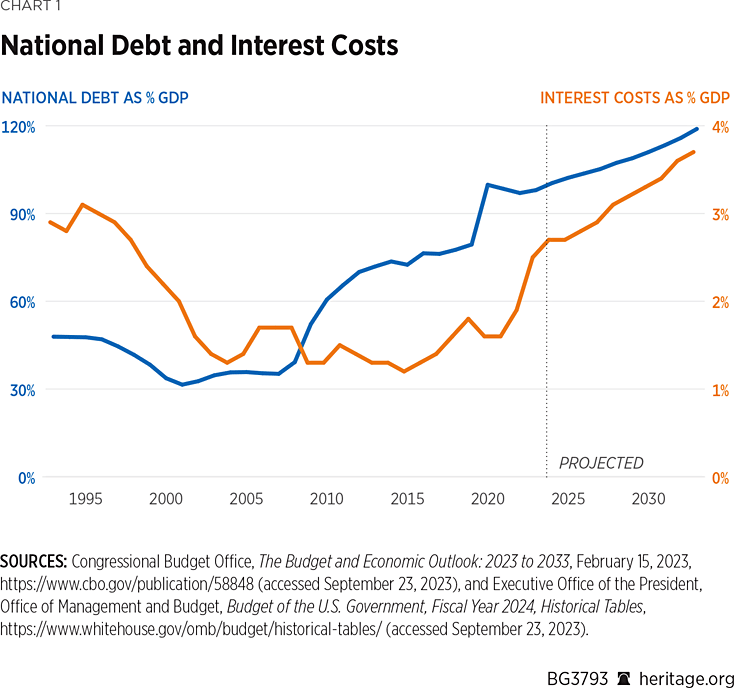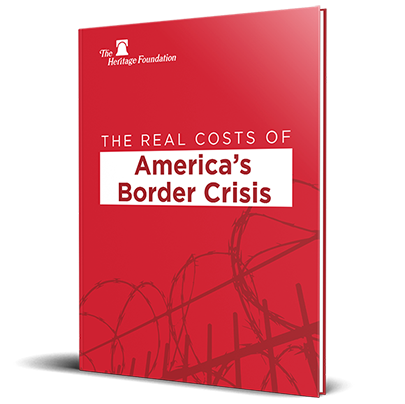Policymakers in Washington have spent most of 2023 in a series of fierce debates over federal spending and the national debt. Despite passage of the Fiscal Responsibility Act,REF which established discretionary spending levels for fiscal year (FY) 2024 and FY 2025 and suspends the debt limit until January 2025, there is still an impasse over how to address the pending set of appropriations bills.REF
Despite a brief increase in rhetoric from political figures about the need to reduce federal deficits, several measures under consideration by Congress stand to increase spending and deficits. This approach to legislating—based on a temporary and now-exhausted ability to add to the national debt without significant short-term economic consequences such as inflation—has been the default approach among members of both parties for many years. However, the $7.5 trillion spending spree from 2020–2022 and its economic aftermath, including a credit downgrade on U.S. debt, have brought an end to the feasibility of casual deficit spending,REF making it imperative that both legislators and the public generally recognize this new reality.
Active and potential legislative proposals to bolster the Disaster Relief Fund (DRF); address the ongoing military conflict in Ukraine; reauthorize the so-called Farm Bill suite of programs; adjust Social Security benefits for government workers; and reauthorize activity by the Federal Aviation Administration (FAA) all would increase federal outlays and authorizations with little or no attempt to cover the costs. While this approach may be politically convenient, it is utterly reckless given current economic conditions and the bleak fiscal outlook facing the nation.
Every dollar the federal government spends has a cost, both in the short term and in the long term. Lawmakers have a moral obligation to recognize these costs and rein in their ambitions. This means reforming or eliminating existing programs, offsetting any new spending with real savings elsewhere in the federal budget, and reducing rather than increasing federal deficits.
This report discusses the genesis and demise of low-consequence deficit spending and addresses how legislators should adjust to the new reality. Congress can either choose to make a bad situation worse or show real leadership and chart a responsible course for the nation’s future.
Origin and Consequences of Congress’s Addiction to Deficit Spending
From the early 1980s through the late 2010s, the U.S. experienced long-term declines in both interest rates and inflation.REF One of the secondary effects of this trend was a reduction in the relative cost of financing the national debt with interest payments falling from 3.1 percent of gross domestic product (GDP) in 1995 to 1.4 percent of GDP in 2005 and 1.2 percent in 2015.REF The national debt fell as a share of the economy between 1995 and 2005 through a combination of economic growth and relative spending restraint. Debt then rose markedly between 2005 and 2015 without causing a corresponding increase in sustained debt servicing costs because of low overall interest rates.REF

For legislators, this created strong political incentives to spend now and let others worry about paying for it later. Ordinary households cannot spend far more than they earn year after year because they are not allowed to take out debt in their children’s and grandchildren’s names, but Congress can do this, and that is exactly what it has done.
Federal lawmakers have used a combination of deficit spending and budgetary gimmicksREF to add new entitlement programs, address domestic and foreign emergencies, and provide favors to political allies without having to face the same choices that families do—either to increase revenues or to reduce expenditures. Examples include wasteful and ineffective “stimulus” packages in 2009, 2020, and 2021; large deficit-financed bailouts of the Highway Trust Fund in 2008, 2015, and 2021; and sizeable responses to highly destructive hurricanes in 2005 and 2017.REF
The spending binge reached new heights from 2020 through 2022 as several spending packages—most of them with bipartisan support—added trillions of dollars to both short-term and long-term deficits. While some of the spending addressed the self-inflicted economic harm of COVID-19 lockdowns, a substantial amount consisted of opportunistic spending for the benefit of special interests.REF
The enormity of the spending spree overwhelmed the long-term trends of declining inflation and low interest rates. Beginning in 2021, inflation spiked to the highest levels in decades with the glut of deficit spending as one of the key factors.REF Though the inflation rate has declined since then, it remains well above pre-pandemic levels. Prices have jumped 16 percent since President Biden took office, and households have lost purchasing power as a result.REF In response to surging inflation, the Federal Reserve has repeatedly raised interest rates, harming financial markets and increasing the cost of financing the federal debt.REF
Growing interest payments create two crowding-out effects.
- Government-issued debt competes with private borrowing in the market, reducing access to capital for new and expanding enterprises.
- As debt takes up a larger share of the federal budget, it leaves less fiscal space for such priorities as national defense and pro-growth tax policy.
Over time, there will also be an increasing risk of a debt crisis should there be an unexpected spike in interest rates.REF
The near-term economic consequences of ongoing deficit spending are compounded by the dire long-term fiscal outlook. Major benefit programs such as Social Security and Medicare have over $75 trillion in unfunded liabilities, and the Congressional Budget Office (CBO) projects permanent $2 trillion annual deficits starting in FY 2030. There currently is no sustained legislative effort to address these monumental imbalances.REF The Fitch credit agency downgraded its rating of the U.S. federal government in August 2023, citing long-standing political dysfunction and mounting obligations.REF
Although the era of “free” spending is over, however, legislators are trying to deny the fiscal laws of gravity yet again.
Fresh Deficit Spending in Forthcoming Legislation
Several pieces of pending or expected legislation would unjustifiably increase direct deficit spending or authorize future increases.
Ukraine, Disaster, and Border Supplemental. On August 10, 2023, the Biden Administration requested $40 billion in supplemental appropriations to support Ukraine’s war effort, replenish depleted U.S. military stocks, provide relief from natural disasters, and address the immigrant crisis at the southern border.REF This spending would be deemed an “emergency,” which means that it would not count toward discretionary spending caps and instead would be fully deficit financed unless Congress decided to include budgetary offsets.
The Biden Administration’s request is a textbook example of Congress’s lazy and irresponsible approach to budgeting and legislating.
- The supplemental package would affect FY 2024 appropriations in the middle of the legislative process for the regular appropriations bills. While the given reason for taking the “emergency” route is to expedite the funding, the true rationale is clearly to bypass the discretionary spending caps because there is little interest among the leaders of either party in finding $40 billion in FY 2024 savings to offset the new spending.
- The battle for Ukraine, natural disasters, and the border crisis are all serious issues, and all are problems of which legislators were fully aware at the start of the appropriations process. Accordingly, use of the “emergency” designation for most (if not all) of the provisions in the request is at best disingenuous. Although exactly when and where natural disasters occur is hard to predict, the fact that they occur every year is common knowledge and means that it is possible to plan for them. Congress should have budgeted for responses to these situations, even if that required politically inconvenient trade-offs.
- Bundling these disparate topics into a single vehicle is a third tactic for prioritizing political expediency over careful policymaking. The grab-bag approach is designed to get supporters of spending for each discrete item to form an alliance that can overwhelm opposition from deficit hawks. By adding at least one seemingly “must-pass” item to the package, proponents try to make final passage seem inevitable and brand opponents as unreasonable or heartless in order to dodge a substantive debate about fiscal policy altogether.
Beyond these broad considerations, provisions in the supplemental request are riddled with policy concerns that Congress needs to fix.
Ukraine. The supplemental requests a total of $24.1 billion for Ukraine: $13.1 billion for military aid and replenishment of weapon stockpiles, $8.7 billion for humanitarian aid, and $2.3 billion to address the Ukrainian economy in conjunction with the World Bank.
There can be no doubt that the situation in Ukraine warrants careful attention from both Congress and the executive branch. However, Washington’s current approach is littered with flaws.
- Despite the massive volume of military and humanitarian aid provided to Ukraine to date, there has been a severe lack of oversight and transparency with respect to how the aid is used.REF
- Continuing to add to the national debt by sending billions of dollars of non-military aid to Ukraine is not responsible statecraft. European nations have the means to provide for the humanitarian and economic needs of Ukrainian civilians. Therefore, they—not the already burdened American taxpayer— ought to be primarily responsible for addressing the region’s geopolitical concerns.
- Proponents of aid to Ukraine often use soaring rhetoric about the importance of continued U.S. support. With the federal government projected to spend $80 trillion from FY 2024 through FY 2033,REF there are hundreds of opportunities to offset the cost of additional aid by eliminating wasteful bureaucracies and reforming dysfunctional programs. However, policymakers show no inclination to offset the cost of any past or future aid to Ukraine.
Congress should reject the Biden Administration’s request for supplemental aid to Ukraine. Instead, legislators should address the conflict through the FY 2024 appropriations process, demand more strategic clarity and transparency from the Biden Administration, and offset the cost of any additional aid by reducing low-priority spending elsewhere in the federal budget.
The Border Crisis. The supplemental request includes $4 billion to “manage the Southwest border safely and effectively.” While this is often referred to as “border security,” the reality is that the spending would not make progress toward preventing future surges of migrants but would instead merely address aftereffects.REF In fact, by funneling more grants to non-governmental organizations (NGOs) that relocate migrants across the country and provide social services, the net result will be to continue incentivizing border crossing and human trafficking.REF
Further, 20 percent of the “border” funding is devoted to services for Ukrainian refugees, which is on top of billions in humanitarian aid to Ukraine elsewhere in the request. This is a clear use of bait-and-switch tactics to conflate the Ukrainian war with the crisis at America’s southern border even though they are entirely separate issues.
It should come as no surprise that the Biden Administration is not interested either in securing the border or in addressing the human costs of the crisis. Congress should reject this portion of the supplemental request entirely and use the FY 2024 appropriations process to steer border and immigration enforcement policy in the right direction.REF
Disasters. The supplemental request includes $12 billion for the Disaster Relief Fund (DRF). Although this provision does not involve the level of controversy associated with the Ukraine and border situations, there are still substantial policy considerations that Congress should consider carefully.
DRF funds are used in responding to natural disasters such as hurricanes and wildfires, but they also continue to be spent on COVID-19 treatments and vaccinations even though the disease has shifted from a public health emergency to one of many other conditions addressed by the health care system. In FY 2023, the DRF is expected to spend $24.9 billion on COVID-19 response with New York State alone accounting for $6.8 billion. In FY 2024, estimated COVID-related spending falls to $4.7 billion, which is still substantial.
The federal government has showered hundreds of billions of dollars in aid on state governments since the beginning of the pandemic in March 2020, and much of this money has been squandered or remains unspent.REF To the extent that COVID-19 merits an ongoing public health response, state governments should lead the way rather than relying on yet more handouts from Washington.
In recent decades, federal expenditures on disasters have increased, and the federal cost share of disaster response has risen to 75 percent or more. The increasing federal involvement has led to many instances of grossly wasteful spending and mismanagement that have cost taxpayers tens of billions of dollars.REF
Although individual disaster events are not predictable, different types of disasters overwhelmingly affect a relatively small number of states based on geographic and topographic conditions. The continued high federal share of disaster costs is therefore a de facto subsidy for disaster-prone regions at the expense of low-risk regions. This amounts to a wealth transfer of dubious justification. Further, the subsidy encourages underinsured development in high-risk regions, which in turn makes subsequent disasters more costly. Congress should reduce the federal share of disaster-related funding, which would in turn reduce the need to keep topping up the DRF with deficit-financed supplemental bills.REF
Finally, it is important to note that the DRF receives funding through the normal appropriations process. Both the House and Senate draft versions of FY 2024 appropriations provide $20.26 billion for the DRF. The supplemental request, if passed, would be added to that amount.
Farm Bill. One of the quintessential congressional legislative log-rolling exercises is the so-called Farm Bill, a combination of agriculture, welfare, and “conservation” programs. Each of these policy areas has a different core political constituency and policy goal. Combining them into a single package consolidates special-interest support and ensures maximal total spending.
The current authorization for the Farm Bill program bundle is set to expire on September 30. It appears doubtful that both chambers will agree to a new bill in time, which means that an extension of unknown length for the 2018 bill is likely.REF However, there are clear contours of debate in each policy area.
Agriculture. Farm income reached an all-time nominal high in 2022, as both agricultural inputs and products have experienced price inflation in recent years. Although there is an expectation that profits for agribusinesses will decline in 2023, they should remain at a historically strong level.REF In addition, the farming sector has exceptionally healthy balance sheets with low debt relative to assets and inflation-adjusted farm equity roughly doubling since 2000.REF
However, proponents of farm subsidies are not content with the sector’s strong financial health and seek to use government guarantees to lock in already high profit margins. In particular, there is a push to increase “reference prices” for key commodities.REF Such a change would trigger more and higher payments through the Price Loss Coverage (PLC) program, which takes effect when the price of a given commodity falls below a certain threshold.REF This would increase spending on the farm subsidies relative to the CBO baseline.
Increasing reference prices would be the latest instance of federal micromanagement of the agricultural sector at taxpayer expense. This is unhealthy both because of its baleful effect on the national debt and because of its interference with the market, the results of which are rampant political favoritism, inefficiency, and dependence on corporate welfare.REF In the case of reference prices, increasing PLC guarantees would make farmers less responsive to price signals that would otherwise cause shifts in how and what they choose to produce. Price signals are a central factor in how markets enhance wealth and prosperity, and prolonged government interference increases the risk of stagnation and political capture by elite interests.REF
Welfare. From a fiscal perspective, the most important aspect of the Farm Bill is food assistance programs, primarily the Supplemental Nutrition Assistance Program (SNAP), better known as food stamps. Federal spending on food stamps surged during the pandemic and remains elevated due to the Biden Administration’s unilateral decision to increase benefit levels significantly through the Thrifty Food Plan.REF
There are many reasons to reform these welfare programs. Not only does the spending add to federal deficits, but benefit increases encourage destructive behaviors, eroding family formation and job-seeking.REF This promotes cyclical poverty and social dysfunction in both individual households and low-income areas.
Accordingly, conservatives have made welfare reform a priority in 2023.REF By seeking reforms such as stronger work requirements, conservatives prioritize the encouragement of healthy social choices with budgetary savings as a helpful aftereffect.REF The House-passed Limit, Save, Grow ActREF contained work reforms, but the debt limit deal eroded those reforms so badly that the CBO estimated it would lead to a net increase in food stamp spending.REF
As a result, the welfare reform debate has shifted to the Farm Bill, and Democrats are already pushing back against the prospect of stronger work requirements.REF Because the Biden Administration has caused a significant increase in food stamp spending, a failure to pass meaningful work reforms or undo the Administration’s actions would mean that Congress is signing off on a deficit-funded spending increase relative to the 2018 Farm Bill. Inaction is not a responsible option.
Conservation. The Farm Bill also includes billions of dollars per year in funding for programs that supposedly are focused on reducing the environmental impact of farming. However, the poor design of these programs coupled with the Biden Administration’s political opportunism means that big agribusinesses reap huge financial windfalls from conservation and related “climate” programs for marginal environmental benefits.REF In many cases, the federal government pays farming operations for things that they have a financial incentive to do anyway.
The Biden Administration’s $3.1 billion Partnership for Climate-Smart Communities fund, carved out of the larger Commodity Credit Corporation (CCC) fund, is a perfect example of the flaws inherent in federal conservation and agricultural policy.REF The program was not directly authorized by Congress and has dubious legal justification, delivers enormous corporate welfare payments during a time of deficit-fueled inflation, and is as much about micromanaging the private sector as it is about supposedly saving the planet.
As with food stamps, a failure to undo the Biden Administration’s actions would mean de facto congressional approval of higher deficit spending on “conservation.”
Foreign Aid. On September 6, Senate Agriculture, Nutrition, and Forestry Committee Chairman Debbie Stabenow (D–MI) and Ranking Member John Boozman (R–AR) sent a letter to Secretary of Agriculture Tom Vilsack, requesting that he use CCC funds to increase spending on food-based foreign aid and trade promotion.REF The letter seeks to use the CCC fund to increase both agricultural subsidies and foreign aid outside of the normal legislative process, avoiding budgetary rules that would be in play if the spending was directly included in the Farm Bill. However, such a maneuver would not avoid adding to the crushing burden of the national debt.
The letter is a perfect distillation of how Members of Congress are willing to abdicate their responsibilities both as legislators by pleading to the executive branch and as national leaders by ignoring the consequences of additional deficit spending. This situation highlights the urgency of the need to reform the CCC’s overly broad spending authority.REF
Social Security for Government Workers. Instead of correcting an outdated method for calculating Social Security benefits for certain government workers at little or no cost, lawmakers are considering a proposal that would reinstate a major and unintended flaw in Social Security’s calculations while costing $183 billion over the next decade and causing Social Security to become insolvent more than a year earlier, in 2032.
Social Security is designed to be contributory and progressive, which means that benefits are based on how much individuals pay into the system and that lower-income earners receive proportionally higher benefits (relative to their prior earnings). Having been designed at a time when few married women participated in the formal labor force, Social Security also includes a spousal benefit so that individuals who do not work long enough to receive a benefit of their own can receive a benefit equal to half of their spouse’s benefit.
While nearly all workers and employers must now pay into Social Security, some jobs—namely, state and local government jobs—were previously exempt from Social Security, and a few remain exempt. Because Social Security benefits are based on average earnings over 35 years and years spent working in exempt or non-covered employment are counted as having $0 of earnings, workers with exempt earnings appear to have lower lifetime earnings. Consequently, these individuals received a “windfall benefit” that was proportionally higher than the amount they would have received if all their earnings were taken into account.
Similar to some workers previously receiving windfall benefits based on their own earnings, some workers also used to receive windfall spousal benefits as a result of working in non-covered employment. Those non-covered years made workers look like stay-at-home spouses with no earnings when in fact they were working and earning pensions outside the Social Security system. Thus, these individuals received their own pensions and Social Security spousal benefits that were meant for individuals who were without their own pensions.REF
In response to these windfall benefits, Congress passed the Government Pension Offset (GPO) in 1977 and the Windfall Elimination Provision (WEP) in 1983. At the time, sufficient earnings records did not exist to provide an appropriate fix—one that provided Social Security benefits in proportion to the time workers spent in covered employment while paying Social Security taxes. Consequently, the GPO and WEP resulted in some people having their Social Security benefits reduced by more or less than a fair amount.
Today, sufficient earnings records exist to provide a correct proportional fix that would preserve Social Security’s intent while reducing its financial shortfalls.REF This proportional fix can be implemented in a way that creates a transition to protect individuals already in or near to retirement from unexpected benefit reductions.
However, rather than correcting the current problem of an imprecise benefit offset formula, lawmakers in the House and Senate have proposed a bill, the Social Security Fairness Act of 2023 (H.R. 82 and S. 597), that would eliminate the WEP and GPO altogether.REF According to a CBO estimate, this proposal to return to the flawed formulas of more than 40 years ago by eliminating the WEP and GPO would cost $183 billion over the next 10 years and cause Social Security to become insolvent more than a year earlier, in 2032.REF When Social Security becomes insolvent, all retirees will be subject to 23 percent benefit cuts with an average loss of more than $5,000 per year for a typical retiree.REF
A proposal recently reintroduced by Representative Jodey Arrington (R–TX), the Equal Treatment of Public Servants Act of 2023 (H.R. 5342), would achieve a fair and accurate long-run fix for the WEP.REF H.R. 5342 includes a full WEP fix for individuals who retire in 2068 or later (effectively, people born in 2000 or later) and allows the benefits received by everyone retiring in 2067 or earlier to be the larger of the amount calculated under the current, flawed formula or the amount calculated under the newly corrected formula. Social Security’s Chief Actuary estimated that an earlier version of the Equal Treatment of Public Servants Act would cost $26.3 billion over the first 10 years and be revenue neutral over the long term.REF
The Equal Treatment of Public Servants Act could be improved by gradually phasing in the fix over the next 30 years instead of allowing retirees to receive the better of both calculated amounts for 45 years. Moreover, adding a similar fix for the GPO would provide a comprehensive solution that calculated benefits fairly while strengthening Social Security’s solvency and minimizing future benefit reductions already incorporated into current law.
Congress has four choices. Members can:
- Do nothing, at zero cost; or
- Enact the Social Security Fairness Act of 2023, which would increase 10-year deficits by $183 billion and hasten Social Security’s insolvency by more than a year; or
- Pass the Equal Treatment for Public Servants Act to provide a long-run fix for the WEP at a small short-term cost and zero long-term cost; or (ideally)
- Pass an expedited and expanded version of the Equal Treatment for Public Servants Act (with a near-term phase-in for the WEP and the addition of a similar fix for the GPO) that could reduce Social Security’s long-run shortfalls.
The fact that many Members of both the House and Senate have chosen to cosponsor the Social Security Fairness Act is a testament to how little regard Congress has for fiscal responsibility.
Federal Aviation Administration Reauthorization. The U.S. government funds and regulates the aviation industry in a far more comprehensive and expensive way than peer nations do, and Congress should avoid making an already overburdened system worse.
Airport funding. The federal government operates the Airport Improvement Program (AIP), which subsidizes infrastructure, and the Essential Air Service (EAS) program, which mostly subsidizes operations for small, remote airports. These programs are funded primarily by taxes on commercial passenger tickets and international overflight fees, respectively.
Such subsidies are less common or necessary in countries where most airports are private entities. However, in the U.S., the overwhelming majority of airports are publicly owned and operated. The federal role in maintaining this harmful status quo includes a limit on so-called Passenger Facility Charges, which are airport user fees. As a result, U.S. airports have a harder time properly funding their own infrastructure development, and this breeds a reliance on federal handouts.REF
Both the House and Senate bills maintain the airport funding status quo and would authorize spending increases without offsetting savings.
It is worth noting that an obscure congressional scorekeeping treatment causes certain infrastructure funds such as the Airport and Airway Trust Fund to count as mandatory budget authority and discretionary outlays. As a result, infrastructure spending increases often appear less expensive than they really are, because the scoring of authorizing legislation focuses on mandatory outlays rather than authority, and scoring of appropriations focuses on discretionary budget authority rather than outlays. In the context of the House FAA reauthorization, this budgetary sleight of hand means understating the bill’s net price tag by over $6 billion because outlays from an increase in the Airport Improvement Program are not counted against the bill.REF
Government-Funded and Government-Operated Air Traffic Organization (ATO). While nations such as Canada and the United Kingdom have shifted to private, nonprofit air traffic control systems, which result in better performance and lower burdens for taxpayers, the U.S. system is stagnant and struggling.REF Neither the House nor the Senate bill addresses the need for fundamental ATO reform.
The FAA spending increase is especially unjustified after tens of billions in airport subsidies from the 2021 infrastructure package, along with tens of billions in aviation handouts contained in pandemic-era spending packages.REF
Conclusion
Supporters of the spending measures referenced in this report will likely portray these choices as either supporting or deserting particular groups of people, but such an argument is both one-sided and shortsighted. Someone eventually has to pay for the new spending. Rising interest rates and heightened concerns about a fiscal crisis could mean that younger and future taxpayers pay twofold or threefold for things that are far outside of the federal government’s purpose, and a fiscal crisis would even restrict core federal government services that they receive.
It is common to see the small handful of fiscal conservatives in Congress condemned for occasionally wanting Congress to be subject to even an ounce of the budget constraints that ordinary Americans face every day.REF Rank-and-file legislators in both parties should recognize that the truly extreme policy position—especially in today’s changed circumstances—is routine support for deficit spending. They should understand that the alternative to reckless debt-mongering is not anarchy, but prioritization. That means focusing federal resources on areas where the federal government has a proper role to play and reducing activity in areas where civil society, businesses, and state and local governments are the primary actors. The benefits go beyond fiscal security to include greater personal liberty and economic growth.
Getting the federal government and Congress to live within their means will not be easy, but it will be easier to do before the federal government faces the equivalent of a household being reported to debt collectors and having their credit cards revoked. For the sake of the opportunity, prosperity, and strength that have made the U.S. a beacon to the rest of the world for generations, it is vital that legislators and the public unite and bring an end to business-as-usual deficit spending.
David Ditch is Senior Policy Analyst in the Grover M. Hermann Center for the Federal Budget at The Heritage Foundation. Rachel Greszler is a Senior Research Fellow in Economics, the Budget, and Entitlements in the Hermann Center.





